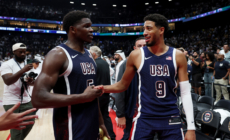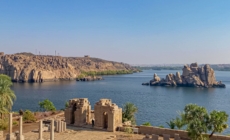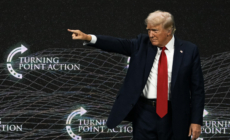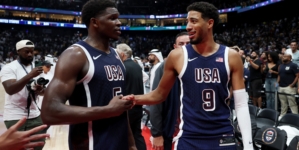-
Vivian Jenna Wilson, Elon Musk’s Transgender Daughter, Says He Was ‘Cruel’ and ‘Uncaring’ - 13 mins ago
-
How to Watch Men’s Basketball at the 2024 Paris Olympics: Streams, Schedule - 39 mins ago
-
Trump, Honing Attacks on Harris, Casts Her as a Far-Left Threat - 57 mins ago
-
Woman Explains Why She Decided To Have Rescue Dog Euthanized Over Behavior - about 1 hour ago
-
Justice Dept. Defends TikTok Law That Forces App’s Sale or Ban - 2 hours ago
-
Archaeologists Find Ancient Egyptian Artworks Hidden Below Nile Waters - 2 hours ago
-
Trump Warns of Vote Rigging, Asks Christians to Vote ‘Just This Time’ - 2 hours ago
-
Léon Marchand: The French Swimmer Who Is Carrying His Country on His Back - 2 hours ago
-
L.A. neighborhood hit by burglars for at least the third time in July - 3 hours ago
-
Harrison Butker’s Comments on Olympics Opening Ceremony Goes Viral - 3 hours ago
Solar eclipse: How to safely use your smartphone for photos
Interested in taking a photo of Monday’s upcoming solar eclipse without ruining your smartphone?
Here are some tips. And remember: Don’t look at the sun with the naked eye, which puts you at risk for permanent eye damage.
Don’t aim your phone camera lens at the sun for long periods of time without a special filter
Casually including the sun in a photo for a quick snapshot isn’t really a safety issue for the camera. It’s not that different from the many photos we typically take of sunrises and sunsets.
“But we would not recommend pointing it directly at the sun for extended periods of time with no filter,” according to Google’s Pixel camera team.
“There’s not really a case of damage there, provided you don’t try to do anything funny like just leave it out there with the camera open for a long time,” said Ed Krupp, the longtime director of the Griffith Observatory.
Krupp suggested shooting wide-angle views with a smartphone; the sun in the photo will look small, “but you’ve got the landscape around there.”
For up-close shots, put eclipse glasses or certified solar filters over the camera lens
Putting a special solar filter over the lens protects the camera, NASA says.
If you’re lucky enough to be within the 115-mile-wide path of totality — which stretches through states like Texas, Illinois, Ohio and New York — “make sure to remove the filter so you can see the sun’s outer atmosphere — the corona,” NASA says.
Those few minutes when the moon completely blocks the sun are also the only time it’s safe to look at the eclipsed sun without wearing special glasses. Totality won’t be viewable from anywhere in California in this eclipse.
During totality, a panorama shot may be able to capture the wraparound sunrise-sunset effect.
If you’re propping your smartphone up against a telescope or binoculars, it’s essential a solar filter is put on the outermost lens of the latter. Putting a cellphone camera against an unfiltered telescope or binoculars aimed at the sun could damage the phone camera and harm the eyes, as the magnifying power of the devices intensifies the sun’s powerful rays.
You can use black tape or a cloth to cut down on the light between the solar filter and the camera lens.
Tripods also can be helpful. And practicing ahead of the eclipse is smart.
There are a number of paid apps that can help people plan for taking eclipse photos, specifically timed outdoor shots: PhotoPills, Planit Pro and the Photographer’s Ephemeris.
What about the chance for clouds?
Keep an eye on the forecast for Monday. One tool is going to the National Weather Service’s website, weather.gov, and typing in your ZIP code. The weather in Southern California could be highly variable Monday morning, with some areas seeing partly cloudy skies and others seeing sunny skies, according to the forecast as of Wednesday.
The National Weather Service’s Weather Prediction Center issues daily maps showing forecast cloud cover for the eclipse for the contiguous U.S.
Any other tips for iPhone, Samsung or Pixel users?
iPhone users
In the camera settings, check the “macro control” option and make sure this mode is not enabled if you’re using a filter in front of the lens or you’re putting your phone up to a telescopic eyepiece. A yellow flower icon indicates that “macro” mode is on; tap that icon to turn it off.
During totality, ultrawide and wide cameras can help when it feels dark, as well as “night mode.” Try tapping on the eclipsed sun to capture the best exposure.
Samsung users
On Reddit, one user who described taking a photo of last year’s annular solar eclipse put solar filters over the lens and used the “pro mode, with ISO set to 50 and reduced the exposure and shutter speed till the exposure looked about right.”
Another user on a Samsung message board suggested practicing ahead of the eclipse, with the filter on, when it’s sunny. “You’re going to want to keep your shutter speed pretty low and focus mainly on ISO,” the user said.
Pixel users
On the Pixel 8 Pro, try out “pro controls,” or manual focus.
Got a GoPro?
GoPro says no solar filter is needed on its devices, and offers a comprehensive tip sheet. One idea the company offers is using the time-lapse mode to “capture the most compelling footage of the entire spectacle,” but it also said it’s important to have a stable tripod and enough battery, and to frame the shot so the sun will remain for the duration of the video. GoPro suggests using sun-tracking apps Sun Surveyor or PhotoPills.
Source link


















